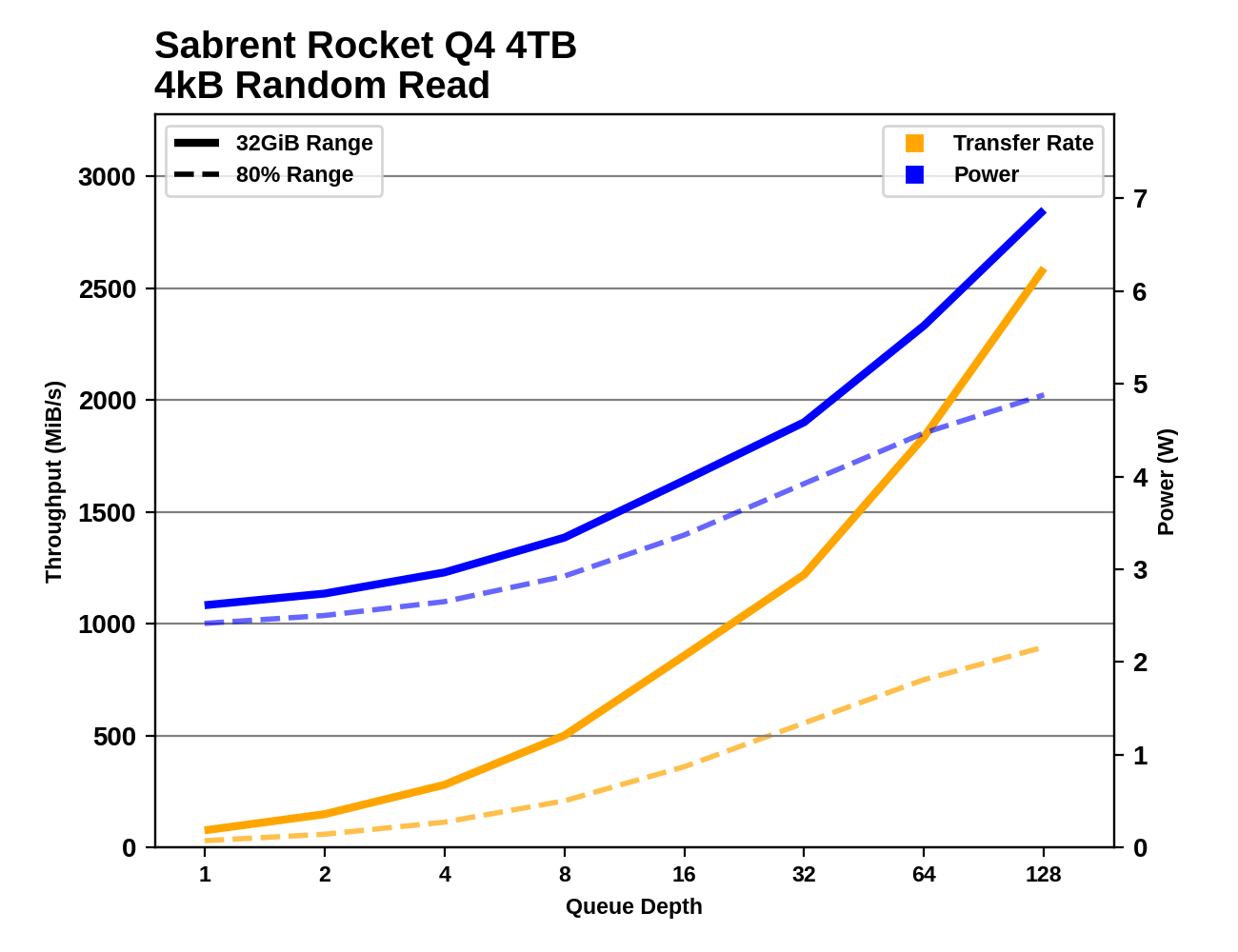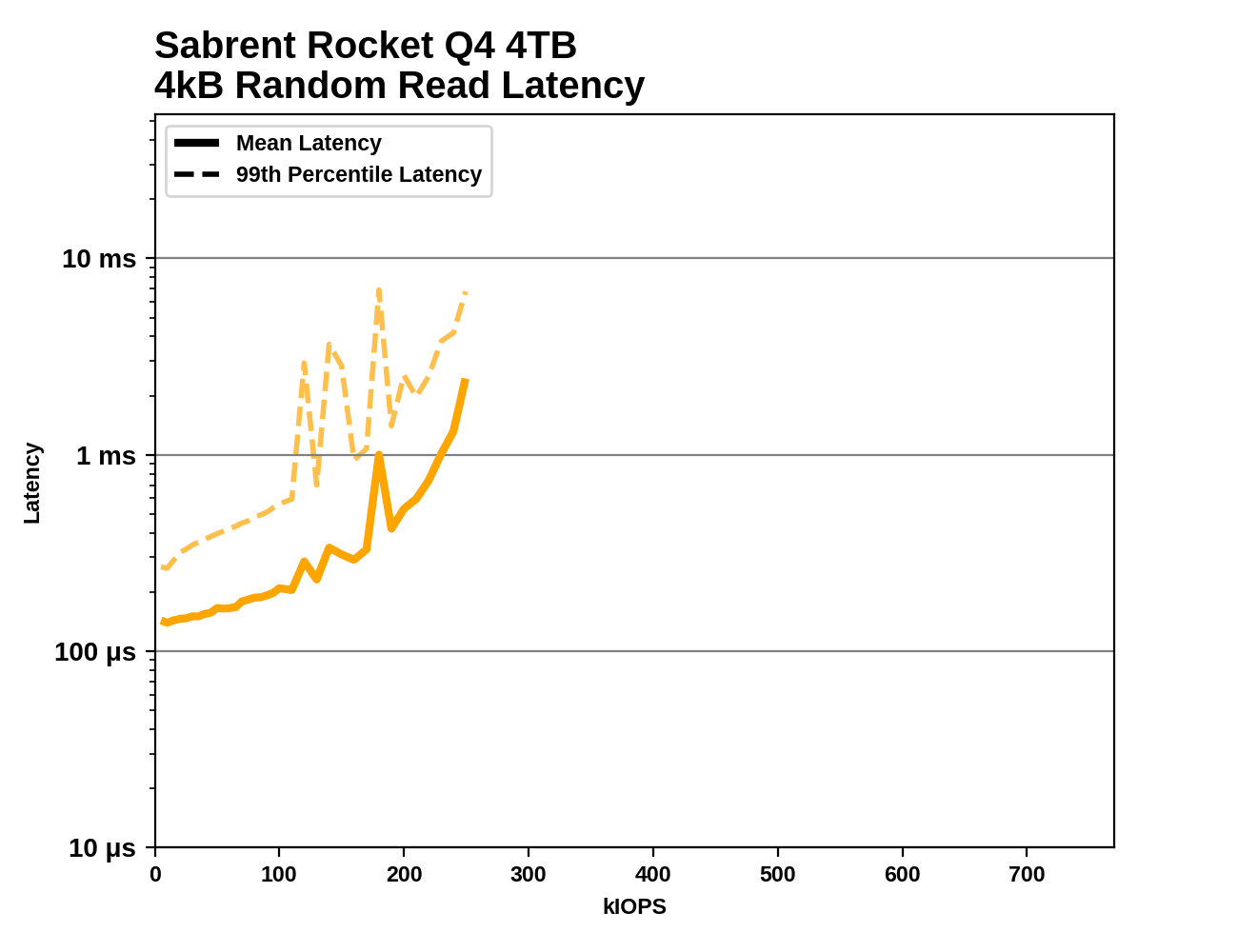Sabrent Rocket Q4 and Corsair MP600 CORE NVMe SSDs Reviewed: PCIe 4.0 with QLC
by Billy Tallis on April 9, 2021 12:45 PM ESTBurst IO Performance
Our burst IO tests operate at queue depth 1 and perform several short data transfers interspersed with idle time. The random read and write tests consist of 32 bursts of up to 64MB each. The sequential read and write tests use eight bursts of up to 128MB each. For more details, please see the overview of our 2021 Consumer SSD Benchmark Suite.
 |
|||||||||
| Random Read | Random Write | ||||||||
| Sequential Read | Sequential Write | ||||||||
The random read performance from the SLC caches on the Rocket Q4 and MP600 CORE are plenty fast, albeit still not able to match the Intel SSD 670p. Outside the cache, the two Phison E16 QLC drives are definitely slower than mainstream TLC drives, but their performance is fine by QLC standards.
For short bursts of writes that don't overflow the SLC cache, these drives are very fast and their caches are still useful even when the drive as a whole is 80% full.
As is often the case for Phison-based drives, the low queue depth sequential read performance is still not great, but sequential writes are very fast and do reach PCIe Gen4 speeds.
Sustained IO Performance
Our sustained IO tests exercise a range of queue depths and transfer more data than the burst IO tests, but still have limits to keep the duration somewhat realistic. The primary scores we report are focused on the low queue depths that make up the bulk of consumer storage workloads. For more details, please see the overview of our 2021 Consumer SSD Benchmark Suite.
 |
|||||||||
| Random Read | Throughput | Power | Efficiency | ||||||
| Random Write | Throughput | Power | Efficiency | ||||||
| Sequential Read | Throughput | Power | Efficiency | ||||||
| Sequential Write | Throughput | Power | Efficiency | ||||||
The random read performance from the Rocket Q4 and MP600 CORE is greatly improved over the earlier Phison E12 QLC SSDs, at least when the test is hitting a narrow slice of the drive that should be entirely within the SLC cache. Random and sequential write results are both decent given that these are in many ways still low-end drives. These two drives are large enough (and have enough SLC cache) to handle much larger bursts of writes than 1TB models, even when the drives are 80% full.
 |
|||||||||
| Random Read | |||||||||
| Random Write | |||||||||
| Sequential Read | |||||||||
| Sequential Write | |||||||||
The E16-based QLC drives are able to continue scaling up random read throughput (from the SLC cache, at least) long past the points where other QLC drives hit a performance wall. The 4TB Rocket Q4 scales better than the 2TB MP600 CORE, and by QD128 it is handling random reads at 2.5GB/s and still has headroom for more performance. For random writes, the Rocket Q4 and MP600 CORE saturate around QD4 or a bit later, which is fairly typical behavior.
When testing sequential reads, we get the characteristic behavior from Phison controllers: poor throughput until around QD16 or so, at which point there's enough data in flight at any given time to allow the SSD controller to stay properly busy. The sequential write results are messy since both drives run out of SLC cache frequently during this test, and that makes it hard to identify what the performance limits would be in more favorable conditions. But it appears that sequential write speed is saturating around QD2, and stays flat with increasing queue depth except when the caching troubles come up.
Random Read Latency
This test illustrates how drives with higher throughput don't always offer better IO latency and Quality of Service (QoS), and that latency often gets much worse when a drive is pushed to its limits. This test is more intense than real-world consumer workloads and the results can be a bit noisy, but large differences that show up clearly on a log scale plot are meaningful. For more details, please see the overview of our 2021 Consumer SSD Benchmark Suite.
 |
|||||||||
The Sabrent Rocket Q4 and Corsair MP660 CORE show better latency on this test than the other low-end NVMe drives, but all the mainstream TLC drives with DRAM have clear advantages. Even the Samsung 870 EVO has lower latency until it gets close to saturating the SATA link. Between the 2TB MP600 CORE and the 4TB Rocket Q4, the larger drive unsurprisingly can sustain higher random read throughput and its latency climbs more gradually, but the Rocket Q4 does have more transient latency spikes along the way.










60 Comments
View All Comments
phillyry - Friday, April 9, 2021 - link
Thank you for actually posting a table with each of the controllers for the drives instead of assuming we've memorized them all. It's helpful Billy. You guys should explicitly state this in all of your reviews (even if you just say the controller in brackets beside the sdd name).JoeDuarte - Friday, April 9, 2021 - link
Billy, what is this part supposed to say?"competing against drives the cheaper TLC NAND SSD vendors that cut corners."
(On the first page.)
Oxford Guy - Sunday, April 11, 2021 - link
QLC itself is cut corners.You're getting only a 30% density increase for double the voltage states. Diminished returns.
StrangerGuy - Saturday, April 10, 2021 - link
2TB QLC for $300.*yawn*
Oxford Guy - Sunday, April 11, 2021 - link
That kind of pricing should be a scandal.Two years ago Black Friday had NVME PCI-e 3 TLC drives for $200.
Oxford Guy - Sunday, April 11, 2021 - link
'But as more SSD vendors adopt QLC NAND in a wider range of products, some are starting to challenge the assumption that QLC is only for low-quality bargain products.'30% density gain for twice as many voltage states is diminished returns, not an assumption.
QLC working against consumer value by inflating the price of TLC (due to reduction in its economy of scale) is not an assumption either.
GeoffreyA - Sunday, April 11, 2021 - link
I think the folk pushing QLC are trying to sweep its identity under the carpet, in order to sell it at TLC prices. That's their goal. They aren't willing to accept that this is a weaker technology and must be sold at a cheaper price. Sadly, it looks as if TLC will end up being "Pro" and QLC the standard. Their itching, greedy fingers will make sure.It's as if they're trying to sell margarine at the price of butter and working tirelessly to make people forget there even was any difference between the two. "This *is* butter. Go for it. Your heart will thank you."
Katana1074@hotmail.com - Sunday, April 11, 2021 - link
As Usual QLC endurance sucks big time....Oxford Guy - Tuesday, April 13, 2021 - link
'I think the folk pushing QLC are trying to sweep its identity under the carpet'Samsung does that. It labels QLC drives '4-bit MLC' or something. Disgusting.
back2future - Sunday, April 11, 2021 - link
What's the difficulties, if one bit or even one sector is not readable anymore, because of drift inside on cell delivers wrong bit value?What are nowadays updates to data retention?
https://www.anandtech.com/show/9248/the-truth-abou...